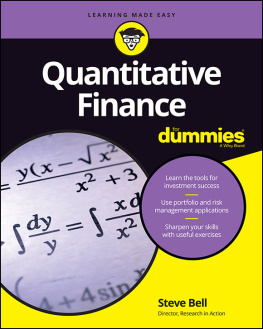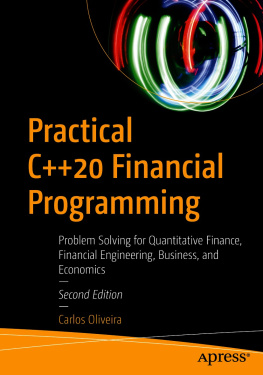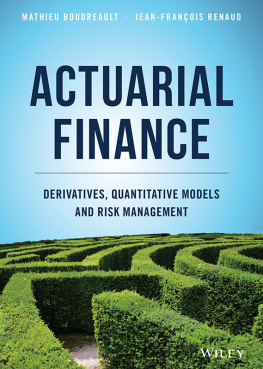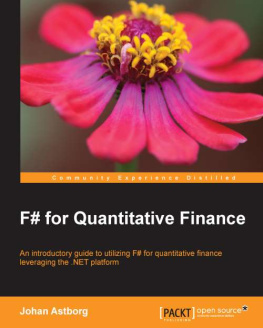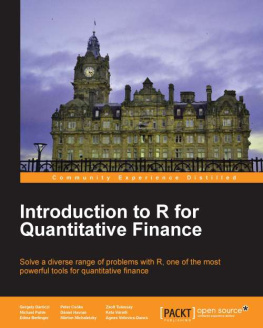Mazzoni - A first course in quantitative finance
Here you can read online Mazzoni - A first course in quantitative finance full text of the book (entire story) in english for free. Download pdf and epub, get meaning, cover and reviews about this ebook. City: Cambridge;United Kingdom New York Melbourne New Delhi Singapore, year: 2018, publisher: Cambridge University Press, genre: Children. Description of the work, (preface) as well as reviews are available. Best literature library LitArk.com created for fans of good reading and offers a wide selection of genres:
Romance novel
Science fiction
Adventure
Detective
Science
History
Home and family
Prose
Art
Politics
Computer
Non-fiction
Religion
Business
Children
Humor
Choose a favorite category and find really read worthwhile books. Enjoy immersion in the world of imagination, feel the emotions of the characters or learn something new for yourself, make an fascinating discovery.

A first course in quantitative finance: summary, description and annotation
We offer to read an annotation, description, summary or preface (depends on what the author of the book "A first course in quantitative finance" wrote himself). If you haven't found the necessary information about the book — write in the comments, we will try to find it.
Mazzoni: author's other books
Who wrote A first course in quantitative finance? Find out the surname, the name of the author of the book and a list of all author's works by series.
A first course in quantitative finance — read online for free the complete book (whole text) full work
Below is the text of the book, divided by pages. System saving the place of the last page read, allows you to conveniently read the book "A first course in quantitative finance" online for free, without having to search again every time where you left off. Put a bookmark, and you can go to the page where you finished reading at any time.
Font size:
Interval:
Bookmark:
A First Course in Quantitative Finance
This new and exciting book offers a fresh approach to quantitative finance and utilizes novel new features, including stereoscopic images which permit 3D visualization of complex subjects without the need for additional tools.
Offering an integrated approach to the subject, A First Course in Quantitative Finance introduces students to the architecture of complete financial markets before exploring the concepts and models of modern portfolio theory, derivative pricing, and fixed-income products in both complete and incomplete market settings. Subjects are organized throughout in a way that encourages a gradual and parallel learning process of both the economic concepts and their mathematical descriptions, framed by additional perspectives from classical utility theory, financial economics, and behavioral finance.
Suitable for postgraduate students studying courses in quantitative finance, financial engineering, and financial econometrics as part of an economics, finance, econometric, or mathematics program, this book contains all necessary theoretical and mathematical concepts and numerical methods, as well as the necessary programming code for porting algorithms onto a computer.
Professor Dr. Thomas Mazzoni has lectured at the University of Hagen and the Dortmund Business School and is now based at the University of Greifswald, Germany, where he received the 2014 award for excellence in teaching and outstanding dedication.
THOMAS MAZZONI
University of Greifswald


University Printing House, Cambridge CB2 8BS, United Kingdom
One Liberty Plaza, 20th Floor, New York, NY 10006, USA
477 Williamstown Road, Port Melbourne, VIC 3207, Australia
314321, 3rd Floor, Plot 3, Splendor Forum, Jasola District Centre, New Delhi 110025, India
79 Anson Road, #06-04/06, Singapore 079906
Cambridge University Press is part of the University of Cambridge.
It furthers the Universitys mission by disseminating knowledge in the pursuit of education, learning, and research at the highest international levels of excellence.
www.cambridge.org
Information on this title: www.cambridge.org/9781108419574
DOI: 10.1017/9781108303606
Thomas Mazzoni 2018
This publication is in copyright. Subject to statutory exception and to the provisions of relevant collective licensing agreements, no reproduction of any part may take place without the written permission of Cambridge University Press.
First published 2018
Printed in the United Kingdom by Clays Ltd.
A catalog record for this publication is available from the British Library.
Library of Congress Cataloging-in-Publication Data
ISBN 978-1-108-41957-4 Hardback
ISBN 978-1-108-41143-1 Paperback
Cambridge University Press has no responsibility for the persistence or accuracy of URLs for external or third-party internet websites referred to in this publication and does not guarantee that any content on such websites is, or will remain, accurate or appropriate.
Modern financial markets have come a long way from ancient bartering. They are highly interconnected, the information is very dense, and reaction to external events is almost instantaneous. Even though organized markets have existed for a very long time, this level of sophistication was not realized before the second half of the last century. The reason is that sufficient computing power and broadband internet coverage is necessary to allow a market to become a global organic structure. It is not surprising that such a self-organizing structure reveals new rules like for example the no arbitrage principle. What is surprising is that not only the rules, but also the purpose of the whole market seems to have changed. Nowadays, one of the primary objectives of an operational and liquid financial market is risk transfer. There are highly sophisticated instruments like options, swaps, and so forth, designed to decouple all sorts of risks from the underlying contract, and trade them separately. That way market participants can realize their individually desired level of insurance by simply trading the risk. Such a market is certainly not dominated by gambling or speculation, as suggested by the news from time to time, but indeed obeys some very fundamental and deep mathematical principles and is best analyzed using tools from probability theory, econometrics, and engineering.
Unfortunately the required mathematical machinery is not part of the regular education of economists. So the better part of this fascinating field is often reserved to trained mathematicians, physicists, and statisticians. The tragedy is that economists have much to contribute, because they are usually the only ones trained in the economic background and the appropriate way of thinking. It is not easy to bridge the gap, because often economists and mathematicians speak a very different language. Nevertheless, the fundamental structures and principles generally possess more than one representation. They can be proved mathematically, described geometrically, and be understood economically. It is thus the goal of this book to navigate through the equivalent descriptions, avoiding unnecessary technicalities, to provide an unobstructed view on those deep and elegant principles, governing modern financial markets.
This book consists of four parts and an appendix, containing a short introduction to complex analysis. is devoted to fixed-income markets and their derivatives. This is in some way the supreme discipline of quantitative finance. In ordinary derivative pricing, the fundamental quantities are prices of underlying securities, which can be understood as single zero-dimensional objects. In pricing fixed-income derivatives, the fundamental quantities are the yield or forward curve, respectively. They are one-dimensional objects in this geometric view. That makes life considerably more complicated, but also more exciting.
This book is meant as an undergraduate introduction to quantitative finance. It is based on a series of lectures I have given at the University of Greifswald since 2012. In teaching economics students I learned very rapidly that it is of vital importance to provide a basis for the simultaneous development of technical skills and substantial concepts. Much of the necessary mathematical framework is therefore developed along the way to allow the reader to make herself acquainted with the theoretical background step by step.
To support this process, there are lots of short exercises called quick calculations. Here is an example: Suppose we are talking about the binomial formulas you know from high school, in particular the third one
 (1.1)
(1.1)
Now its your turn.
Quick calculation 1.1 Show that 899 is not a prime number.
If you are looking for factors by trial and error, this surely will be no quick calculation and you are on the wrong track. At least you missed something, in this case that 899 = 302 12, and thus 31 and 29 have to be factors.
There are also more intense exercises at the end of each chapter. Their level of difficulty is varying and you should not feel bad if you cannot solve them all without stealing a glance at the solutions. Some of them are designed to train you in explicit computations. Others provide additional depth and background information on some topics in the respective chapter, and still others push the concepts discussed a little bit further, to give you a sneak preview of what is to come.
Font size:
Interval:
Bookmark:
Similar books «A first course in quantitative finance»
Look at similar books to A first course in quantitative finance. We have selected literature similar in name and meaning in the hope of providing readers with more options to find new, interesting, not yet read works.
Discussion, reviews of the book A first course in quantitative finance and just readers' own opinions. Leave your comments, write what you think about the work, its meaning or the main characters. Specify what exactly you liked and what you didn't like, and why you think so.



